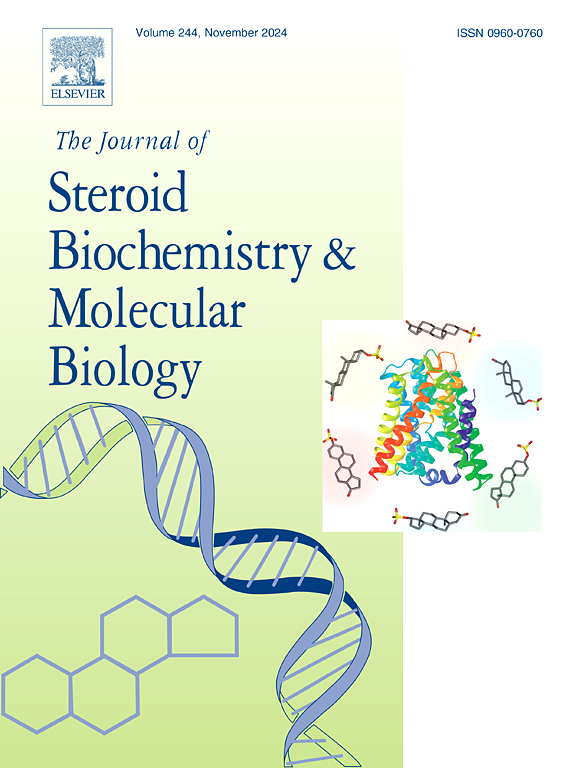四甲基吡嗪和依伏二胺对子宫内膜异位症发展的协同抑制作用
IF 2.7
2区 生物学
Q3 BIOCHEMISTRY & MOLECULAR BIOLOGY
Journal of Steroid Biochemistry and Molecular Biology
Pub Date : 2024-10-30
DOI:10.1016/j.jsbmb.2024.106630
引用次数: 0
摘要
子宫内膜异位症(EMS)属于一种妇科疾病,其炎症和子宫内膜样组织存在于子宫腔之外,常常导致不孕和盆腔疼痛。雌激素受体β(ERβ)在子宫内膜异位症(EMS)中有显著表达,并被认为是通过抑制ERβ活性来治疗EMS的一个有前景的治疗靶点。本研究探讨了四甲基吡嗪(TMP)介导的ERβ抑制的潜在机制,以及TMP和依维地胺(EVO)对ERβ表达和EMS发展的协同抑制作用。我们发现,TMP通过减少Oct3/4与ERβ启动子的结合,降低Oct3/4蛋白水平而不影响Oct3/4转录本水平,从而抑制ERβ的表达。抑制 ERβ 表达至少需要 10 µM 的 TMP 剂量。单独使用 TMP(5 µM)或 EVO(2 µM)都没有任何效果,但它们的组合能协同抑制 ERβ 的表达,并调节相关的细胞过程,包括氧化还原平衡、线粒体功能、炎症和增殖。此外,在小鼠模型中,TMP(10 毫克/公斤体重)和 EVO(5 毫克/公斤)的组合能协同抑制 ERβ 的表达和 EMS 的发展。总之,TMP通过减少Oct3/4与ERβ启动子的结合来抑制ERβ的表达。在实验室和活体模型中,单独使用 TMP 或 EVO 都不能有效抑制 ERβ。然而,它们的组合能协同抑制ERβ的表达和EMS的发展,这表明使用TMP和EVO是一种潜在的EMS治疗策略。本文章由计算机程序翻译,如有差异,请以英文原文为准。
Synergistic inhibitory effects of tetramethylpyrazine and evodiamine on endometriosis development
Endometriosis (EMS) belongs to a gynecological disorder with inflammation and the existence of endometrial-like tissues beyond the uterus, often leading to infertility and pelvic pain. Estrogen receptor β (ERβ) is significantly expressed in endometriosis (EMS) and recognized as a promising therapeutic target for EMS treatment by inhibiting ERβ activity. In this study, we investigated the potential mechanisms for tetramethylpyrazine (TMP)-mediated ERβ suppression, and the synergistic inhibitory effect of TMP and evodiamine (EVO) on ERβ expression and EMS development. We found that TMP suppresses ERβ expression by reducing the association of Oct3/4 with the ERβ promoter and decreasing Oct3/4 protein levels without affecting Oct3/4 transcript levels. A minimum dosage of 10 µM TMP is required to inhibit ERβ expression. Neither TMP (5 µM) nor EVO (2 µM) alone had any effect, but their combination synergistically inhibited ERβ expression and modulated related cellular processes, including redox balance, mitochondrial function, inflammation, and proliferation. Additionally, the combination of TMP (10 mg/kg body weight) and EVO (5 mg/kg) synergistically inhibited ERβ expression and EMS development in the mouse model. In conclusion, TMP suppresses ERβ expression by reducing the association of Oct3/4 with the ERβ promoter. Neither TMP nor EVO alone effectively suppresses ERβ in both laboratory and live organism models. However, their combination synergistically inhibits ERβ expression and EMS development, suggesting a potential therapeutic strategy for EMS using TMP and EVO.
求助全文
通过发布文献求助,成功后即可免费获取论文全文。
去求助
来源期刊
CiteScore
8.60
自引率
2.40%
发文量
113
审稿时长
46 days
期刊介绍:
The Journal of Steroid Biochemistry and Molecular Biology is devoted to new experimental and theoretical developments in areas related to steroids including vitamin D, lipids and their metabolomics. The Journal publishes a variety of contributions, including original articles, general and focused reviews, and rapid communications (brief articles of particular interest and clear novelty). Selected cutting-edge topics will be addressed in Special Issues managed by Guest Editors. Special Issues will contain both commissioned reviews and original research papers to provide comprehensive coverage of specific topics, and all submissions will undergo rigorous peer-review prior to publication.

 求助内容:
求助内容: 应助结果提醒方式:
应助结果提醒方式:


